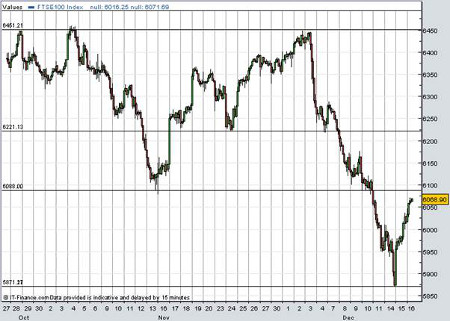Era of record-low interest rates ends now
16th December 2015 13:23
by Lee Wild from interactive investor
Share on
Janet Yellen and her colleagues on the US Federal Open Market Committee (FOMC) will raise interest rates for the first time in almost a decade this evening. Yes, we've been disappointed in the past – rates could have (should have) risen in September – but rate-setters have put themselves in a corner this time and only a hike will keep the market onside.
Despite the recent plunge in global stockmarkets and commodities rout, traders and economists have rarely been more certain about a rate decision. The chance of a US hike at 1900GMT Wednesday is put at a colossal 81.4% by the CME Group's FedWatch tool, which is based on its 30-day Fed Fund futures.
Economic data has been largely supportive, and all the pieces are certainly place. There shouldn't be too much change in Yellen's post-meeting statement either given regular missives from the Fed chair.
"We expect the Fed to continue to sound relatively upbeat on the US economy," writes Deutsche Bank analyst Jim Reid. "Of particular importance will be just how the FOMC chooses to address the gradualism of rate rises. It's likely that Yellen will point to her summary of economic projections and dot plots to help guide this.
"Our US Economics team expect the 2016 and 2017 median dots to remain at 1.38% and 2.63% respectively."
Of course, there's a good chance that recent inflation forecasts will be driven down by the plunge in commodity prices and strong dollar. That would mean a more gradual rate-tightening cycle – the last one in 2004-2006 was ended by the credit crunch. Back in September, Fed members hinted at three hikes in 2016 and between four and five the year after. That would get borrowing costs to about 3.25% long-term.
The Federal Funds rate last rose in June 2006, by 25 basis points to 5.25%. Then, the S&P 500 was trading 770 points lower at around 1,273 and oil was over $73 a barrel.
And investors have chased risk assets higher in the past few sessions ahead of decision time.
"Much of the recent market chatter was that we might see some sort of post-FOMC relief rally although yesterday's decent rebound for risk assets suggests that this might have come a day early," says Deutsche's Reid.
Indeed, the 100 surged 143 points, or 2.4%, Tuesday. It's put on another 54 points since 8am this morning to trade at its highest level since early last Friday. Recent laggards like the oil majors, mining heavyweights, and the Far East-focused banks and lead the way.
Assuming things go as expected, what then?

(Click to enlarge)
Simon French, chief economist at Panmure Gordon, spent the summer analysing previous tightening cycles, and discovered which sectors do best when the Fed is in full flow. "We found that it is the consumer services, technology and telecoms sectors that outperform over the life of a US rate cycle," he says.
But on a short-term horizon, rather than the whole rate cycle, we got a pretty good idea of the likely reaction to a hike a few months ago. In the 12 trading days spanning the end of October and start of November, the odds of a FOMC December hike moved from 23% to 65%.
In that time, the US utilities and real estate sectors - where gearing is most acute - sold off, while banks and healthcare took the lead.
But market volatility based around even expected shifts in policy, which one assumes would already have been priced in, has surprised even French. But there could be an answer.
"The increasing share of algorithmic trading strategies that execute on the confirmation of macro data - that most human traders have already absorbed – has a role. I understand the argument that sophisticated algorithms can adjust for non-linear expectations but when the “rubber hits the road” it is hard for even the most sophisticated algorithms not to react to a three-quarters probability shifting to 100% confirmation."
This article is for information and discussion purposes only and does not form a recommendation to invest or otherwise. The value of an investment may fall. The investments referred to in this article may not be suitable for all investors, and if in doubt, an investor should seek advice from a qualified investment adviser.